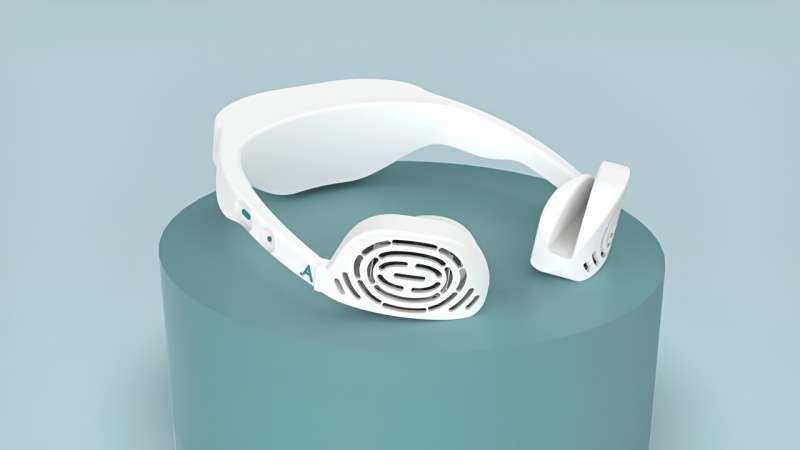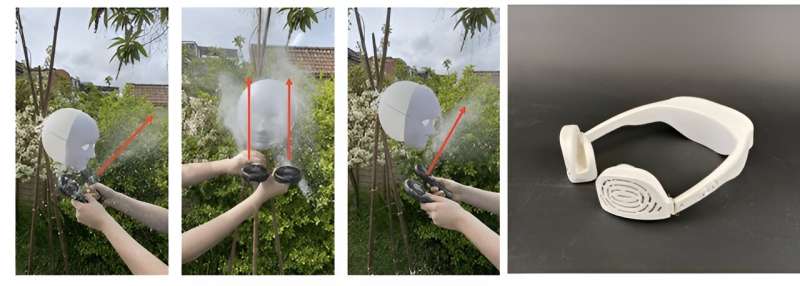This article has been reviewed according to Science X's editorial process and policies. Editors have highlighted the following attributes while ensuring the content's credibility:
fact-checked
trusted source
proofread
Student designs wearable purifier to protect underground train users and improve air quality

Commuters on underground trains worldwide may soon breathe easier, thanks to an invention by a Loughborough University student.
Mia Patterson Cox, a recent Industrial Design and Technology graduate (pictured below), has created "Aerate," a neck-worn air purifier designed to improve air quality for underground train users by filtering out harmful particles present in the environment.
In underground train environments, PM2.5 levels often exceed World Health Organization defined limits. PM2.5 refers to particulate matter less than 2.5 micrometers in size—about 30 times smaller than the diameter of a human hair.
These tiny particles are of concern as they can penetrate deep into the lungs, and some may even get into the bloodstream. Breathing in unhealthy levels of PM2.5 has been linked to respiratory and cardiovascular diseases, as well as cognitive impairments.
Wheel, track, and brake abrasion are often the primary sources of particulate matter in underground train environments, generating iron-rich particles that pollute the air. Poor ventilation in platforms and tunnels exacerbates the problem, exposing commuters to high levels of particulates during their journeys.

Mia first became aware of the pollution problem during her placement year in London as she frequently used underground trains to get to different places.
"I often thought about the hot stuffy environment and would be concerned when I found dust around my nostrils after traveling on underground trains," said Mia, "It made me feel uneasy about the time I spent in the network, prompting me to explore the problem of pollution.
"I wanted to create a product that will increase commuter and passengers' health confidence when traveling underground by removing iron-rich particles in the air."
Mia designed Aerate to create a clean bubble of breathable air around a user's face. It features two fans and Spunbond Polypropylene (SBPP) filters. The fans draw air in and the filters catch particles as small as 2.5 micrometers.

The fans propel purified air in front of the user's face at 5,500 rotations per minute. This continuous flow creates a protective barrier against harmful particles during underground travel, says Mia.
Aerate aims to enhance air quality not only for the wearer but for other commuters too.
Mia explained: "I purposely didn't want to create a product that benefited only the users. By continuously filtering out iron particles and other pollutants, Aerate contributes to a healthier environment for all passengers traveling on underground trains."
In addition to the wearable product, Mia has designed an Aerate app that connects to a particle sensor within the device, providing live data readings on particle exposure.
This app also tells users when it is time to change their filters, which are effective for up to 40 hours of use.

Mia envisions the app being used to help users plan low-pollution journeys by leveraging aggregated data contributed anonymously by Aerate owners.
This data will offer insights into total particle exposure, identify pollution hot spots, and suggest routes that minimize exposure while optimizing speed, convenience, and cost-effectiveness for commuters.
A prototype of the Aerate wearable has been developed, featuring adjustable fan heads, albeit without integrated electronics at this stage.
Mia has conducted extensive rounds of experience prototyping using handheld fans and flour as a substitute for small particles. These tests illustrate Aerate's capability to effectively shield users from airborne particles, says Mia, showcasing its potential effectiveness in real-world scenarios.

Of the ultimate goal for her product, Mia said, "Without Aerate, respiratory conditions can be aggravated, hindering people from reaching their full potential.
"I aim to pave the way for a safer travel experience on underground trains, promoting health and confidence among users and commuters alike."
Aerate was featured in the School of Design and Creative Arts Degree Show and Foundation Exhibition Student Showcase 2024. For more information on the product, visit the exhibition's dedicated webpage.



















